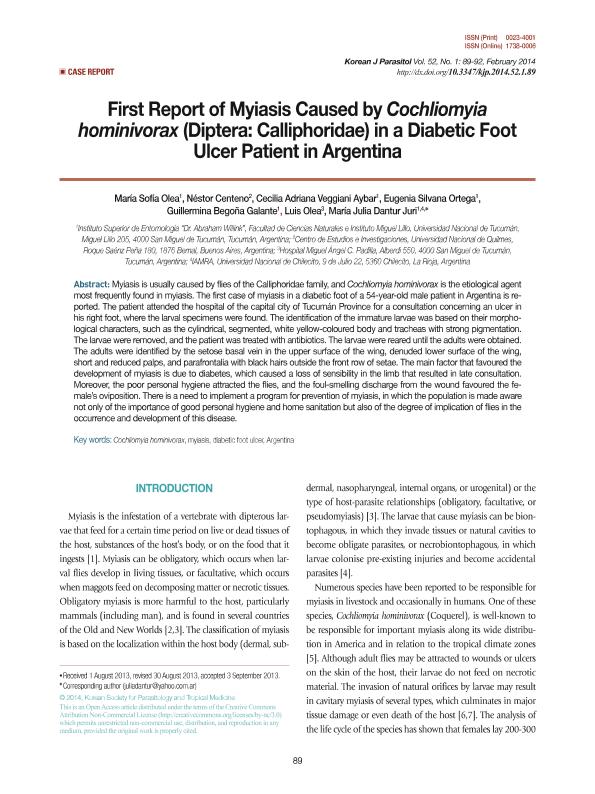Artículo
First Report of Myiasis Caused by Cochliomyia hominivorax (Diptera: Calliphoridae) in a Diabetic Foot Ulcer Patient in Argentina
Olea, María Sofía ; Centeno, Néstor Daniel; Veggiani Aybar, Cecilia Adriana
; Centeno, Néstor Daniel; Veggiani Aybar, Cecilia Adriana ; Ortega, Eugenia Silvana; Galante, Guillermina Begoña; Olea, Luis Segundo; Dantur Juri, Maria Julia
; Ortega, Eugenia Silvana; Galante, Guillermina Begoña; Olea, Luis Segundo; Dantur Juri, Maria Julia
 ; Centeno, Néstor Daniel; Veggiani Aybar, Cecilia Adriana
; Centeno, Néstor Daniel; Veggiani Aybar, Cecilia Adriana ; Ortega, Eugenia Silvana; Galante, Guillermina Begoña; Olea, Luis Segundo; Dantur Juri, Maria Julia
; Ortega, Eugenia Silvana; Galante, Guillermina Begoña; Olea, Luis Segundo; Dantur Juri, Maria Julia
Fecha de publicación:
02/2014
Editorial:
Korean Soc Parasitology
Revista:
Korean Journal Of Parasitology
ISSN:
0023-4001
e-ISSN:
1738-0006
Idioma:
Inglés
Tipo de recurso:
Artículo publicado
Clasificación temática:
Resumen
Myiasis is usually caused by flies of the Calliphoridae family, and Cochliomyia hominivorax is the etiological agent most frequently found in myiasis. The first case of myiasis in a diabetic foot of a 54-year-old male patient in Argentina is reported. The patient attended the hospital of the capital city of Tucumán Province for a consultation concerning an ulcer in his right foot, where the larval specimens were found. The identification of the immature larvae was based on their morphological characters, such as the cylindrical, segmented, white yellow-coloured body and tracheas with strong pigmentation. The larvae were removed, and the patient was treated with antibiotics. The larvae were reared until the adults were obtained. The adults were identified by the setose basal vein in the upper surface of the wing, denuded lower surface of the wing, short and reduced palps, and parafrontalia with black hairs outside the front row of setae. The main factor that favoured the development of myiasis is due to diabetes, which caused a loss of sensibility in the limb that resulted in late consultation. Moreover, the poor personal hygiene attracted the flies, and the foul-smelling discharge from the wound favoured the female’s oviposition. There is a need to implement a program for prevention of myiasis, in which the population is made aware not only of the importance of good personal hygiene and home sanitation but also of the degree of implication of flies in the occurrence and development of this disease.
Palabras clave:
Myiasis
,
Cochliomyia Hominivorax
,
Diabetic Foot
,
Argentina
,
Myiasis
Archivos asociados
Licencia
Identificadores
Colecciones
Articulos(CCT - NOA SUR)
Articulos de CTRO.CIENTIFICO TECNOL.CONICET - NOA SUR
Articulos de CTRO.CIENTIFICO TECNOL.CONICET - NOA SUR
Articulos(MACNBR)
Articulos de MUSEO ARG.DE CS.NAT "BERNARDINO RIVADAVIA"
Articulos de MUSEO ARG.DE CS.NAT "BERNARDINO RIVADAVIA"
Citación
Olea, María Sofía; Centeno, Néstor Daniel; Veggiani Aybar, Cecilia Adriana; Ortega, Eugenia Silvana; Galante, Guillermina Begoña; et al.; First Report of Myiasis Caused by Cochliomyia hominivorax (Diptera: Calliphoridae) in a Diabetic Foot Ulcer Patient in Argentina; Korean Soc Parasitology; Korean Journal Of Parasitology; 52; 1; 2-2014; 89-92
Compartir
Altmétricas



